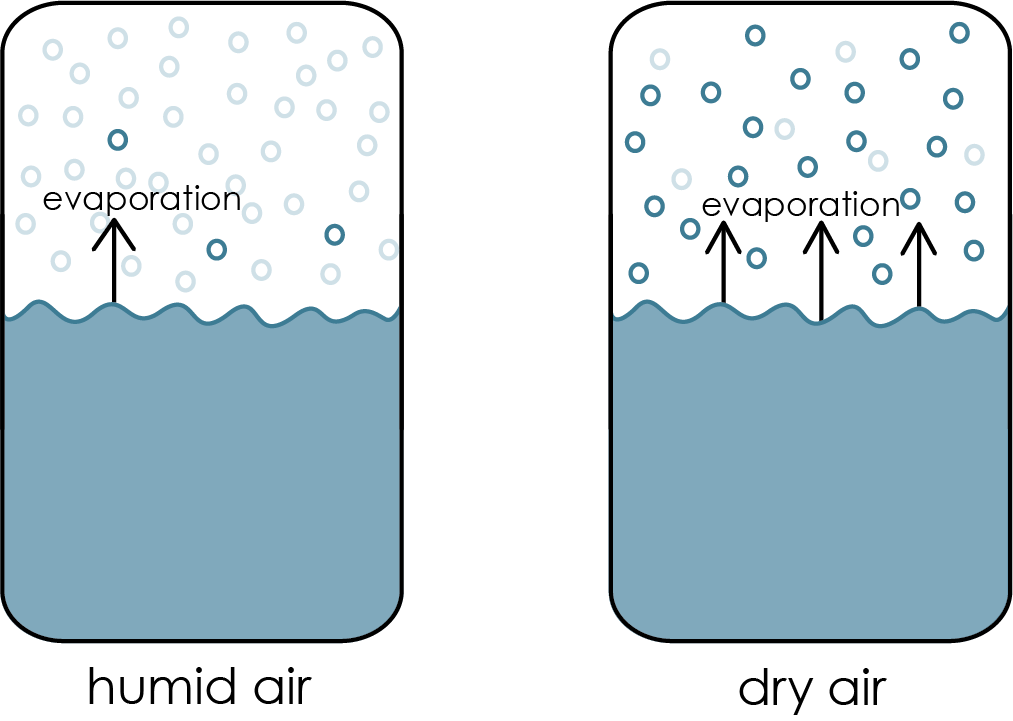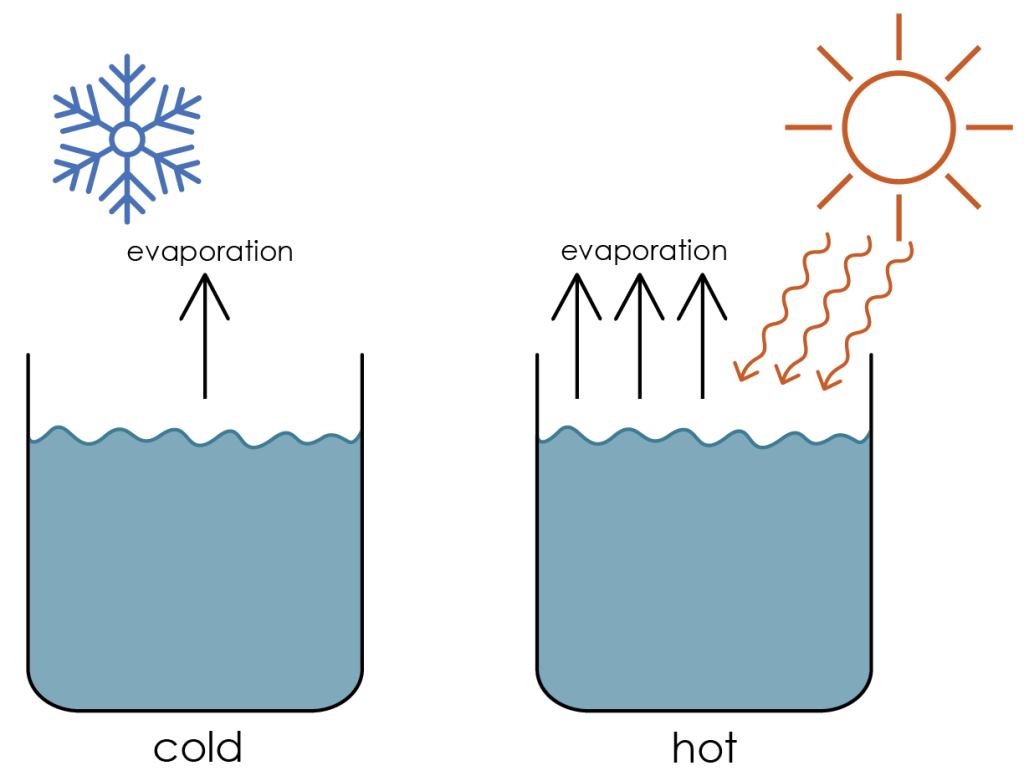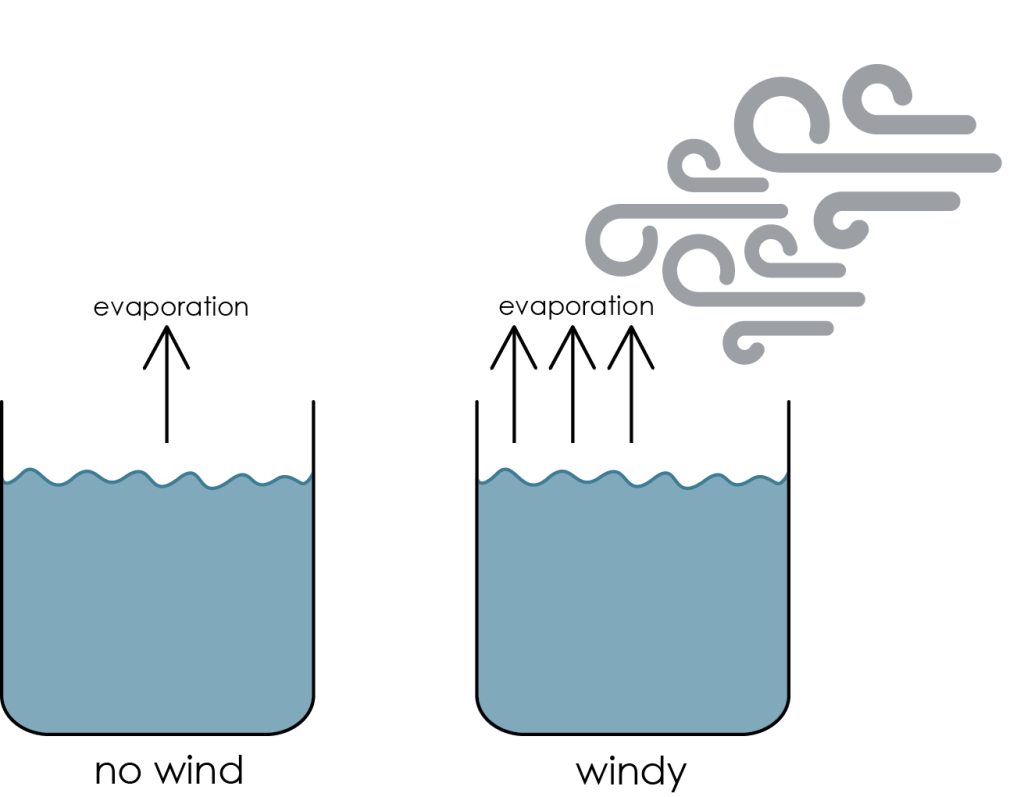2. Controls on Evaporation and Transpiration
As the largest consumptive user of water, sustainable water usage in agriculture is an important focus area for overall water sustainability. This requires understanding where irrigation water comes from and the conditions that affect it.
Plants are a bit like Goldilocks – we do not want to over water them because it is a waste of water and can rot plant roots, but we also do not want to underwater because then plants will not survive. If there is not water available naturally (i.e., from rainfall) to keep plants growing, then we need to use irrigation water and irrigation water is diverted from two stores in the hydrologic cycle: groundwater or surface water. Obviously, not having to use irrigation at all is the most sustainable way to use water in agriculture, but to make sure plants are getting the water they need (whether from rain or irrigation) it is important to understand how precipitation, evaporation, and transpiration (flows in the hydrologic cycle) change with climatic conditions.
Many factors can affect how quickly water will flow from one store to the next, and different processes have different ranges of flow rates. For example, the rate of groundwater flow is much, much slower than surface flow because groundwater must squeeze through tight spaces between sediment grains instead of flowing freely like in a river. But not all groundwater flows at the same rate either. The groundwater flow rate can vary widely depending on the type of rock/soil it is flowing through and how well connected the spaces in the sediment grains are.
Factors affecting rates in surface water flow, such as how fast a river is flowing, are easily visible. Rivers flowing down steep slopes in mountainous areas flow faster than a wide river across a flat landscape. Other flow rates, such as evaporation and transpiration are less visible.
2.1 Evaporation
Evaporation is the process of changing liquid water into gaseous water (water vapor). This is how water moves from Earth’s surface into the atmosphere. How much water evaporates from any surface, whether from a lake’s surface or through the stomata on a plant’s leaf, is influenced by climatic and weather conditions, which include the relative humidity, temperature, and wind (among other factors).
Humidity controls
Humidity is a measure of how much water vapor is in an air mass. The lower the humidity, the drier the air mass and the higher the humidity, the more water vapor is in the air mass. A given mass of air (at a given temperature) can hold a finite amount of water vapor before it is saturated. Once an air mass is saturated, it is not possible to evaporate more water, i.e., you cannot “stuff” more water molecules into the air if there is no room for them. In this way, the humidity levels of the air mass control evaporation. Dry air (low humidity) has more room for water molecules so more evaporation can occur in dry conditions. Humid air already has a lot of its space taken up with water molecules so there is only a little bit of room left to add more, as a result, less evaporation can occur in humid conditions (Figure 2A.2.1).

Temperature controls
Evaporation rates are higher at higher temperatures. High solar radiation and warmer air temperatures transfer heat energy to the water (in soils, plants, lakes, rivers, etc.). As temperature increases, the amount of energy necessary for evaporation decreases which means warmer water evaporates more readily than colder water (Figure 2A.2.2). In other words, in sunny, warm weather evaporation is greater than in cloudy, cool weather. In addition, like dry air, warm air can “hold” more water vapor; there is extra room for water vapor to be stored in warmer air relative to colder air.

Wind controls
As water evaporates it forms a dense (invisible) cloud of water vapor over the area. If this cloud is not carried away, the water vapor molecules can easily interact with liquid water on the landscape and bond again to become liquid. Effectively meaning no evaporation occurred. However, if conditions are windy, the wind can sweep away the cloud of water vapor leaving dry air in its place allowing more evaporation to occur. In this way, windy conditions increase evaporation rates while calm (non-windy) conditions have lower evaporation rates (Figure 2A.2.3).

2.2 Transpiration
Transpiration is the process of moving liquid water from the soil through the plant and evaporated from plant leaves. The water is taken up from the soil through plant roots, moved through the plant to the leaves where it is evaporated from tiny holes on the leaves called stomata. The release of water through stomata also helps cool the plant and drives further water uptake from the soil through the roots and into the plant. This water brings needed nutrients and minerals into the plant. A simple definition for transpiration is the water evaporated from plant leaves. Most of the water brought into a plant moves through and is transpired and only a small fraction (<5%) remains in plant tissues.
As transpiration is an evaporative process, the same factors that control evaporation rates (humidity, temperature, wind) also control transpiration rates. In addition, factors such as the age of the plant, the plant type, and health of the plant will also affect transpiration rates.
The importance of stomata
Stomata also play a key role for plants during photosynthesis and respiration. In addition to water moving through the stomata, carbon dioxide and oxygen also come in and out of the plant through stomata. During photosynthesis plants use energy from the sun to convert carbon dioxide (brought in through stomata) and water to carbohydrates (i.e., food). This process releases oxygen to the atmosphere (also through stomata).
During respiration plants use up the carbohydrates made during photosynthesis and turn them into energy for growth and other life processes. This requires taking in oxygen and releasing carbon dioxide and water through stomata. Respiration is the same process we call “breathing” in animals.
Check your understanding: Evaporation and Transpiration
The map below shows average solar radiation in the U.S. for September. Solar radiation is a measure of how much solar energy is reaching the area and is related to temperature conditions. Darkest red colors have larger amounts of solar radiation and yellow colors are lower amounts of solar radiation. Drag the appropriate evaporation condition (lowest, medium, or highest) to the correct corresponding location on the map.
